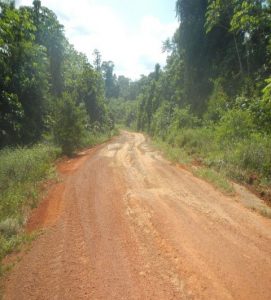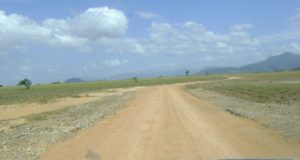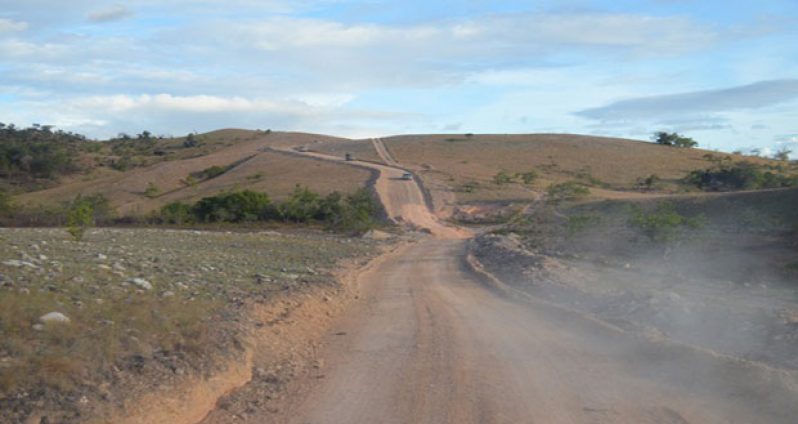ROADS are essential to any country aspiring to become modernised. They are described as a pillar for economic development, since they provide the base for physical connection of centres of economic production. The absence of roads throughout the hinterland regions has been one of the major reasons for hinterland growth and development not progressing at the rate they should.
Establishment of the Hinterland Roads Programme by the People’s Progressive Party/Civic (PPP/C) has effected a greater level of interconnectivity throughout communities, some of which are no longer considered remote.Dream to reality
Some said it was unattainable, others, it was an impossibility in this generation, but what was once a dream has become a reality today! Two of Guyana’s interior regions, where accessibility once was very challenging, have now been linked!

Considered an engineering feat, there is now a road between Regions 8 and 9, stretching dozens of miles into difficult terrain, from Meritzero to Monkey Mountain.
Hinterland Roads Engineer of the Public Works Ministry, Naeem Mohamed, is very proud of this achievement, explaining that this fair weather road links to the Lethem road and leads to villages like Karasabai, Moraibaiko, Yurong Paru, Tiperu and Rukumoto. Not satisfied with this level of development, the Government plans to take the road up to Kato.
Lasting over four years, the 71-mile Karasabai/Monkey Mountain road project was built by several contractors working in phases. Vivekanand Dalip was contracted for the installation of culverts, Cyril King for the installation of bridges (in excess of 1,000 feet in running length), and Omai Gold Mines built the road itself.
To date, the road is almost completed towards the Monkey Mountain end; and although it is a fair weather road, it is a good one. Cars can access it from Meritzero to Karasabai, with the travel time drastically reduced. Prior to the construction, to get to Monkey Mountain it normally took about a day and a half, now people can traverse from Meriterizero to Monkey Mountain in approximately three hours, using a four – wheel vehicle. With the final inspection due with the contractors, that phase of the project is expected to be closed soon, Mohamed said.
Impact
In Regions 8 and 9, commuters are now positively impacted as the Linden/Lethem Road which was once impassable now enables travellers to get to Lethem in about nine hours in good weather. Although the road is designed for 4×4 pick-ups and trucks, cars traverse it as well.
It has opened up opportunities for Region 8 residents to easily transport their produce to market in the busy hub of Lethem.
The road works under the current administration have impacted significantly on Amerindians. First, through accessibility with the price on the Linden/Lethem road being reduced. Guyanese use this road to conduct business in Lethem and Georgetown. The road link created also assists in promoting tourism.
With works being planned on a road from Bartica, this would see access to Mahdia and Monkey Mountain in Region 8. Work is also planned for the Kurupukari Bridge, so that it could create accessibility for Amerindians. When the gaps are closed and tourists visit villages, there would always be a spin-off for Amerindian communities, since they would benefit greatly. They would be able to market their art and craft and agricultural products.
With communication being one important aspect, the roads have allowed the Guyana Telephone and Telegraph (GT&T) Company and Digicel to put up towers in some communities, thus allowing for quicker contact between them and the rest of the country.
Region 1
Major projects in Region 1 include repairs to the road from Port Kaituma to Baramita under two contracts, both totalling approximately $70M. There is also the 28 – mile Santa Rosa/Kwebanna road which would cost approximately $60M.
Repairs to Matthews Ridge/Baramita Road are almost completed. Critical areas were fixed to make the road traversable.
Works currently ongoing in Santa Rosa/Kwebanna are approximately 40 to 50% complete, while some additional works are being done to ensure that the road will remain in good condition over a long period of time. These additional works include stabilising the material that is currently available with cement so that the road would be stronger.
Region 7
In Region 7, repairs were done to the One Mile to Four Mile road in Bartica and the Bartica/Potaro road. Asphalt was used to repair the bad spots on the roads which normally deteriorate every year. However, based on the last inspection made with the asphalt used, good results were seen.
It is expected that the Four Mile to Five Mile on the Bartica/Potaro road would be done since it is in the planning stage. This road is expected to be upgraded.

Region 8
Apart from the road connecting this region to Region 9, the Guyana Geology and Mines Commission (GGMC) did the section of road from the Brian Sucre Junction to Mahdia. While this was basically the same maintenance that the Public Works Ministry does every year, it made a final inspection to ensure that the road is traversable and safe for commuters.
Completed are the rehabilitation of the ‘Wrong Turn’ to the airstrip, rehabilitation of Road Cenotaph to the pavilion and Mahdia to Campbelltown. Other works were done on the Campbelltown roadway and roads in Mahdia, Princeville, and Chenapou were rehabilitated.
Works are ongoing on rehabilitation of the road linking Kato to Chiung Mouth, Mountain Foot to Taruka and Paramakatoi to Bamboo Creek.
Region 9
In Region 9, numerous roads have been done beginning with the Linden to Lethem road, which is approximately 276 miles long. The Ministry of Public Works annually expends in excess of $250 to $300M for maintenance of the roadways. Maintenance would include repairs and rehabilitation to 65 bridges, which are made of both log and timber. With routine maintenance, works would entail grading and shaping, obtaining a saddle-back surface so that water would run off, and bush clearing.
When the road is in bad condition, the travel time basically varies from 18 to 20 hours, but currently the time is nine hours.
Phase Two is currently ongoing on the road, since it was noticed that some of the sections on the road regularly fail. What is being done is additional work on these sections to ensure that when the area experiences torrential rainfall of high intensity, they would stand up to a certain degree. While the road is unsurfaced, Mohamed said they are doing their best to ensure that it would be rigid enough.
Some community roads were also done in Region 9, including the Sand Creek road which cost in excess of $80M; the Masara road which utilised approximately $45M; and the Parashara/Nappi/Haiawa road which took approximately $25M. The outlook now is to do some other village roads in Region 9.
Future plans
Future plans for the hinterland regions would see the Ministry of Public Works ensuring that all the arterial roads are maintained. With most of the Amerindian people living along these areas, this is a first priority.
New roads are being looked at in Region 9, from Karaudaranau to Parabara, some arterial roads from Lethem into Aranaputa; and roads from Katoonarib that branch off in some small villages. Estimates are in hand to be finalised.
In Region 1, other arterial roads are being looked at, these coming from the Santa Rosa/Kwebanna roadway. (GINA)




.png)









